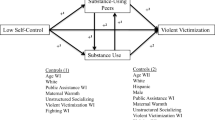Abstract
Previous literature suggests that the adolescent at risk to engage in substance use and other negative health-related behaviors is deviant in a negative sense (i.e., rebellious, antisocial, and alienated from traditional institutions). However, some researchers have distinguished between two types of deviance-a true autonomy and independence that is more positive and constructive, and a reactant “anticonformity” that is more negative and destructive. The current study assessed the roles of both constructive and destructive deviance in adolescent cigarette smoking and positive health-related behaviors. Adolescents who were constructively deviant engaged in higher levels of health-protective behaviors. Moreover, constructive deviance was an independent predictor of both cigarette smoking and positive health behaviors over and above the effects of traditional negative deviance indicators. These data suggest that constructive deviance is not a competing model to more traditional notions, but that it is an additional possible pathway into adolescent positive and negative health behaviors.
Similar content being viewed by others
References
Baumrind, D. (1985). Familial antecedents of adolescent drug use: A developmental perspective. In Jones, C. L., and Battjes, R. J. (Eds.),Etiology of Drug Abuse: Implications for Prevention. National Institute on Drug Abuse, Research Monograph Series 56, U.S. Government Printing Office, Washington, DC.
Brook, J., Lukoff, I., and Whiteman, M. (1977). Peer, family, and personality domains as related to adolescents' drug behavior.Psychol. Rep. 41: 1095–1102.
Brook, J., Whiteman, M., Brook, D., and Gordon, A. (1981). Paternal determinants of male adolescent marijuana use.Develop. Psychol. 17: 841–847.
Brook, J., Whiteman, M., Gordon, A., and Cohen, P. (1986). Dynamics of childhood and adolescent personality traits and adolescent drug use.Develop. Psychiol. 22: 403–414.
Chassin, L. (1984). Adolescent substance use and abuse. In Karoly, P., and Steffen, J. (Eds.),Adolescent Behavior Disorders: Foundations and Contemporary Concerns. Lexington, MA, D. C. Heath.
Chassin, L., Presson, C. C., and Sherman, S. J. (1987). Applications of social developmental psychology to adolescent health behaviors. In Eisenberg, N. (Ed.),Contemporary Topics in Developmental Psychology. New York, Wiley.
Chassin, L., Presson, C. C., Sherman, S. J., Bensenberg, M., Corty, E., and Olshavsky, R. O. (1984). Predicting the onset of adolescent cigarette smoking: A longitudinal study.J. Appl. Social. Psychol. 7: 670–676.
Cox, W. M., Lun, K.-S., and Loper, R. G. (1983). Identifying prealcoholic personality traits. In Cox, W. M. (Ed.),Identifying and Measuring Alcoholic Personality Traits. Francisco, Jossey-Bass.
Cunningham, W. H., Cunningham, I. C. M., and English, W. D. (1974). The sociopsychological characteristics of undergraduate marijuana users.J. Genet. Psychol. 125: 3–12.
Domino, G. (1970). Identification of potentially creative persons from the adjective checklist.J. Consult. Clin. Psychol. 35: 45–51.
Donovan, J. E., Jessor, R., and Costa, F. (1987). Adolescent health behavior and conventionalityunconventionality: An extension of problem-behavior theory. Unpublished manuscript, Institute of Behavioral Science, University of Colorado, Boulder, CO.
Ensminger, M., Brown, C. H., and Kellam, S. (1982). Sex differences in antecedents of substance use among adolescents.J. Social Issues 38: 25–42.
Evans, R., Hansen, W., and Mittelmark, M. (1977). Increasing the validity of self-reports of behavior in a smoking in children investigation.J. Appl. Psychol. 62: 521–523.
Gough, H. G. (1969).Manual for the California Psychological Inventory, Palo Alto, CA, Consulting Psychologists Press.
Hollander, E. P., and Willis, R. H. (1967). Some current issues in the psychology of conformity and nonconformity.Psychol. Bull. 68: 62–76.
Jessor, R., and Jessor, S. L. (1977).Problem Behavior and Psychosocial Development: A Longitudinal Study of Youth. New York, Academic Press.
Johnston, L., O'Malley, P., and Eveland, L. (1978). Drugs and delingquency: A search for causal connections. In Kandel, D. B. (ed.),Longitudinal Research on Drug Use: Empirical Findings and Methodological Issues. New York, Wiley.
Kandel, D. B. (Ed.). (1978).Longitudinal Research on Drug Use: Empirical Findings and Methodological Issues. New York, John Wiley.
Kaplan, H. B. (1980).Deviant Behavior in Defense of Self. New York, Academic Press.
Kellam, S., Brown, C. H., and Fleming, J. (1982). Social adaptation to first grade and teenage drug, alcohol, and cigarette use.J. School Health 301–306.
Nowicki, S., and Strickland, B. R. (1973). A locus of control scale for children.J. Consult. Clin. Psychol. 40: 148–154.
Schlegel, R. P., and DiTecco, D. (1978). Mediational adequacy of the Fishbein model under conditions of varying behavioral complexity. Unpublished manuscript, Department of Kinesiology, University of Waterloo, Ontario, Canada.
Smith, G., and Fogg, C. (1978). Psychological predictors of early use, late use, nad nonuse of marijuana among teenage students. In Kandel, D. B. (Ed.),Longitudinal Research on Drug Use: Empirical Findings and Methodological Issues. New York, John Wiley.
Tarter, R., Alterman, A., and Edwards, K. (1985). Vulnerability to alcoholism in men: A behavior-genetic perspective.J. Studies Alcohol 46: 329–357.
Willis, R. H. (1963). Two dimensions of conformity-nonconformity.Sociometry 26: 499–513.
Zuckerman, M., Eysenck, S., and Eysenck, H. J. (1978). Sensation-seeking in England and America: Cross-cultural, age, and sex comparisons.J. Consult. Clin. Psychol. 46: 139–149.
Zuckerman, M., Kuhlman, D. M., and Camac, C. (1988). What lies beyond E and N? Factor analyses of scales believed to measure basic dimensons of personality.J. Personal. Social. Psychol. 54: 96–107.
Author information
Authors and Affiliations
Additional information
This research was supported by Grant No HD13449 from ther National Institute of Child Health and Human Development to the three authors, and by Grant DA05227 from the National Institute on Drug Abuse to the first author.
Received Ph.D. in Clinical Psychology from Columbia University Teachers College. Current research interests include adolescent substance use and health risk behaviors.
Received Ph.D in Developmental Psychology from Columbia University Teachers College. Current research interests include spatial cognition and adolescent health behaviors.
Received Ph.D. in Social Psychology from University of Michigan. Current interests include social cognition and adolescent health behaviors.
Rights and permissions
About this article
Cite this article
Chassin, L., Presson, C.C. & Sherman, S.J. “Constructive” vs. “Destructive” deviance in adolescent health-related behaviors. J Youth Adolescence 18, 245–262 (1988). https://doi.org/10.1007/BF02139039
Received:
Accepted:
Issue Date:
DOI: https://doi.org/10.1007/BF02139039




